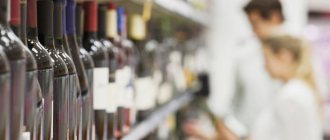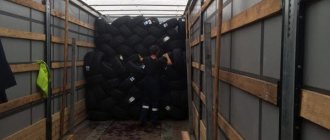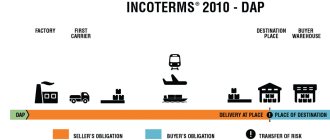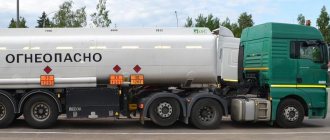Transportation of perishable goods is a very popular service, which in the Russian Federation is provided by specialized transport companies with their own fleet of special equipment.
Refrigerated semi-trailers are used to transport chilled, frozen or fresh perishable products over long distances. Structurally, these semi-trailers are very similar to classic isothermal vans. Thus, they are closed cargo platforms equipped with high-quality thermal insulation, which allows maintaining a given temperature regime.
However, unlike an isothermal van, when transported in refrigerators, the temperature in the cargo compartment can be adjusted manually, providing optimal conditions for transportation and storage of all kinds of food products, including vegetables (cucumbers, potatoes, tomatoes), fruits (bananas, apples, strawberries), meat , fish, milk, etc.
Classification of refrigerated trucks
Trucks equipped with refrigerated semi-trailers are complex and expensive equipment that requires regular maintenance and disinfection of the cargo compartment. The temperature regime during transportation in refrigerators is set according to the parameters of the cargo being transported, for which ready-made diagrams and/or temperature tables are used, for example, for apples, strawberries or specific vegetables.
Optimal conditions in the body of a refrigerator are formed by an autonomous type refrigeration and heating unit (HOU). Temperatures in such a compartment can vary within -20 / +12 degrees Celsius, regardless of external weather conditions.
According to the capabilities of the cold storage device, or more precisely according to the temperature regime that can be created in the cargo compartment, modern refrigerated trucks are divided into the following classes, marked with Latin letters.
- 0 / +12 degrees Celsius – “A”;
- -10 / +12 degrees Celsius – “B”;
- -20 / +12 degrees Celsius – “C”.
In addition, the cargo vehicles in question have their own certification, according to which refrigerators are distinguished:
- FNA – regular class “A”;
- FRA, FRB, FRC – reinforced, respectively, classes “A”, “B” and “C”.
Toxic gases
Quite often you can find the following information: “Don’t buy overseas fruits, you can poison your children.” All such articles refer to the fact that bananas are treated with gas. However, there is no information about what this gas is. It only says that it is toxic and extremely harmful to your health. It can be assumed that an unscrupulous supplier fumigates the fruit with some super-effective compound in order to prevent them from spoiling and give them a beautiful appearance. But all large companies use a cheap and well-known mixture.
Transportation rules
One of the main criteria for using refrigerated trucks is “commodity proximity” when transporting food products. This concept is relevant for the transportation of various goods and types of products, and it cannot be neglected.
The term “commodity neighborhood” refers to specific rules and regulations applicable to refrigerated cargo transportation when transporting consolidated cargo. This is due to the incompatibility of transportation and storage of certain types of products, as well as the need to provide them with different conditions in terms of temperature and humidity.
Competent compliance with the standards of “commodity neighborhood” must be carried out both by those responsible for transportation and by people directly working with food products. The list of the latter includes cooks and sellers, staff of catering establishments, warehouse workers, etc.
Commodity neighborhood rules define products and goods that can be stored and transported together because they require similar temperature and humidity conditions and are stored in a similar way. In addition, the commodity neighborhood regulations identify goods whose transportation in a single compartment is strictly prohibited.
Which bananas are best to eat?
On the market today you can find delicious, ripe, yellow fruits. They are beautiful, presentable and delicious. The best option for serving. There are fruits that are very light in color, with green splashes. They are firm and less sweet. There is also a third option. Yellow, soft, with numerous brown and black specks.
How are bananas treated during transportation? To do this, they use special antibiotics, which allow them to get there without loss. Usually the inside of the box is lined with paper impregnated with a special preparation called sodium pyrosulfate. After this, they undergo carbonation and go on sale. But this does not guarantee long-term preservation. If the fruit is not sold soon, the beautiful yellow skin will turn black.
Which fruits are best to choose? If a banana is green, then due to the excess of starchy substances it is practically not digested in the intestines. This threatens severe gas formation. In this regard, slightly overripe and darkened fruit will cause fewer problems. But it is not recommended to buy a completely black banana.
Temperature of food transportation in refrigerators (table)
| № | Shipping Name | Temperature | Reefer class |
| Fruits | |||
| 1 | Apricots | 0 / +3 С° | class A |
| 2 | Pineapples | +11 C° | class A |
| 3 | Bananas | 0 / +10 C° | class A |
| 4 | Grape | +1 / +9 C° | class A |
| 5 | Cherry | +1 / +2 С° | class A |
| 6 | Pears | +3 / +6 С° | class A |
| 7 | Melons | +7 / +10 С° | class A |
| 8 | Peaches | +5 С° | class A |
| 9 | Plum | +2 / +6 С° | class A |
| 10 | Currant | 0 / +2 С° | class A |
| 11 | Blueberry | 0 / +5 С° | class A |
| 12 | Apples | +4 / +5 С° | class A |
| 13 | Oranges | +2 / +10 C° | class A |
| 14 | Tangerines | +2 / +8 C° | class A |
| 15 | Lemons | +15 C° | class A |
| 16 | Cherries | +4 С° | class A |
| 17 | Watermelon | +4 / +10 С° | class A |
| 18 | Strawberry Raspberry | +2 / +5 С° | class A |
| № | Shipping Name | Temperature | Reefer class |
| Vegetables | |||
| 1 | Eggplant | +7 / +10 С° | class A |
| 2 | Peas | +1 / +4 С° | class A |
| 3 | Zucchini | +1 / +5 С° | class A |
| 4 | Cabbage | +1 / +9 C° | class A |
| 5 | Carrot | +8 C° | class A |
| 6 | cucumbers | +4 / +10 С° | class A |
| 7 | Tomatoes | +5 / +15 C° | class A |
| 8 | Greenery | +1 / +9 C° | class A |
| 9 | Beans | +3 / +10 С° | class A |
| 10 | Asparagus | 0 / +5 С° | class A |
| 11 | Mushrooms | +2 С° | class A |
| 12 | Spinach | +6 С° | class A |
| 13 | Pepper | +4 — /+8 С° | class A |
| 14 | Potato | +5 / +10 С° | class A |
| 15 | Beet | +5 С° | class A |
| 16 | Garlic | +3 С° | class A |
| № | Shipping Name | Temperature | Reefer class |
| Foodstuffs | |||
| 1 | Milk | +8 C° | class A |
| 2 | Eggs | +3 / +7 С° | class A |
| 3 | Cheeses | 0 / +8 С° | class A |
| 4 | Butter | -5 — 0 C° | class B |
| 5 | Vegetable oil | + 3 / + 10 С° | class A |
| 6 | Fish caviar | -5 / 0 C° | class B |
| 7 | Fish oil | 0 C° | class A |
| 8 | Frozen meat | -12 / -18 C° | class C |
| 9 | Chilled meat | -1 / +5 С° | class B |
| 10 | Frozen fish | -18 C° | class C |
| 11 | Chilled fish | — 1 / +3 С° | class B |
| 12 | Lightly and heavily salted fish | — 5 / +2 С° | class B |
| 13 | Canned fish | 0 / +10 C° | class A |
| 14 | Canned food | +15 / +20 C° | class A |
| 15 | Mayonnaise | +3 / +18 C° | class A |
| 16 | Milk | 0 / +8 С° | class A |
| 17 | Dairy | +8 C° | class A |
| 18 | Sausage | +4 С° | class A |
| 19 | Ice cream | -18 C° | class C |
| 20 | Frozen fruits/vegetables | -12 / -20 C° | class C |
Where to store bananas so they ripen
There is a special technology for unripe bananas, with which the fruits can be prepared for sale.
To ensure that bananas ripen evenly, the carbonation method is used.
- Bananas are placed in a special sealed chamber, where they are processed (ripened) with gas mixtures;
- Before ripening, the chamber is preheated to 18 degrees, and then treated with “banana gas” - 5% ethylene, 95% nitrogen. There are several modes of fruit ripening - slow 8 days, medium 6 days, and accelerated 4 days.
- The highest quality product comes from the slow ripening process.
Formation of groupage cargo
The placement of various types of cargo in the body of a refrigerator is carried out in accordance with the specifics and characteristics of the goods.
- Products with a strong odor cannot be transported in the same compartment as products that easily absorb third-party odors. For example, transporting spices and tea in the same van will spoil the tea, which will absorb the odors of the spices.
- The combined transportation of semi-finished products, raw materials and finished products is not permitted, since bacteria from the semi-finished product can spread to food or raw materials. And if in the latter case, heat treatment destroys bacteria, then in the case of finished products they can pose a threat to the life and health of consumers.
- Perishable goods with different “sorption characteristics” must be transported by different refrigerators. The mentioned properties indicate the degree of absorption of atmospheric moisture by the product. Therefore, transporting these goods requires unique conditions. For example, the combined transportation of flour and confectionery products with powdered sugar often causes these goods to become damp, losing not only their presentation, but also their properties.
- Transportation of frozen food products and refrigerated analogues requires maintaining a low temperature. Otherwise, there will be a change in their consumer properties, which will affect demand and revenue, and therefore make transportation unprofitable and even unprofitable.
- Very strict restrictions apply to the joint transport of cargo containing toxic substances. Thus, it is prohibited to transport vegetables and fruits, milk and confectionery, as well as other food products and foodstuffs with chemicals and fuels and lubricants.
Green bananas
Relatively recently, the question of how bananas are processed has arisen in society. In Soviet times, it was difficult to find them on sale (except in the capital), but they were always green. Of course, they looked more like grass and were of no value to the buyer. But some housewives have learned to bring them to ripeness. To do this, you needed to take a paper bag, place bananas lightly sprinkled with water, as well as several ripe red apples. The bag was tightly sealed and left for a day or two. The temperature should have been room temperature.
You won't find green bananas for sale these days. But then, in conditions of a shortage of goods, they were bought with pleasure and tried to bring them “to condition” to the best of their ability. The question of how bananas are processed in order to deliver them to the buyer did not arise at all.
Advantageous offer from professionals
If you need to quickly, safely and inexpensively transport perishable products or cargo with special storage conditions, then contact our company. We provide our clients with the optimal vehicles, including refrigerators with several sealed compartments, carry out all logistics calculations and select the optimal transportation route.
The list of our services also includes activities such as:
- packaging and sealing of goods;
- targeted delivery on a “to-door” basis;
- registration of insurance and accompanying documentation;
- payment of tolls.
We provide these services at the request of the customer, who does not have time to deal with such nuances. You can find out more about the refrigerated food transportation service by following the link .
We will transport your fruits and vegetables reliably and profitably
As discussed above, transporting fruits and vegetables is a process that requires compliance, as well as taking into account many important rules and nuances.
As for our company, we can assure you of the reliability of cooperation with us. Our company’s employees have extensive experience in this matter and not only in theory, but also in practice know all the features of proper transportation of fruits and vegetables.
In addition to reliability, we can offer a number of our competitive advantages that provide you with significant benefits. Here are some of them:
- We have our own vehicles for transporting fruits and vegetables, such as reefers and refrigerated containers. This means that we offer prices without unnecessary markups;
- We have an established partner network consisting of other carriers, which allows us to quickly organize suitable routes in cases where our own vehicles are busy;
- We can provide full support for your cargo . Those. we can help with the preparation and execution of any necessary documents for the transportation of your cargo, as well as resolve issues related to forwarding and insurance;
- We provide a full range of services . In addition to resolving bureaucratic issues, we can also take on issues related to the loading/unloading of your cargo on the principle of door-to-door .
We are sure that you will be satisfied with the cooperation in transporting your fruits and vegetables with!
Cost of transporting products by refrigerator
| Loading point | Unloading point | Refrigerator 82 m³ / 20 t |
| Chelyabinsk | Irkutsk | 220 000 |
| Novosibirsk | 115000 | |
| Omsk | 70000 | |
| Krasnoyarsk | 160 000 | |
| Krasnodar | 80 000 | |
| Vladivostok | 450 000 | |
| Saint Petersburg | 75 000 | |
| Chita | 330 000 | |
| Abakan | 180 000 | |
| Krasnokamensk (Trans-Baikal Territory) | 380 000 | |
| Kazan | ||
| Tyumen | 35 000 | |
| Permian | ||
| Magnitogorsk | ||
| Ust-Kut | ||
| Makhachkala | 130 000 | |
| Grozny | 130 000 | |
| Simferopol | 145 000 | |
| Sochi | 145 000 | |
| Murmansk | 180 000 | |
| Kovdor | 160 000 | |
| Magnitogorsk | Chelyabinsk | |
| Bely Yar | ||
| Ekaterinburg | ||
| Saint Petersburg | Chelyabinsk | 140 000 |
| Ekaterinburg | 135 000 | |
| Tyumen | 140 000 | |
| Permian | 125 000 | |
| Ekaterinburg | Chelyabinsk | 18 000 |
| Saint Petersburg | 75 000 | |
| Tyumen | ||
| Abakan | 180 000 | |
| Krasnodar | 80 000 | |
| Krasnoyarsk | 160 000 | |
| Novosibirsk | ||
| Krasnodar | Chelyabinsk | 135000 |
| Magnitogorsk | 130 000 | |
| Ekaterinburg | 140 000 | |
| Prices are based on a full truck load. Prices for groupage cargo will vary depending on the weight and volume of goods transported. | ||
Affordable treat
It can be argued that today it is possible to transport fruits carefully and quickly through air freight. This is how ripe mangoes come to our table, as well as the freshest seafood that was caught just this morning. All this is true, but compare the prices of mangoes or king prawns and ordinary bananas. It is logical to assume that they are not brought in individually, taking care of each fruit individually. Therefore, the question arises: “How are bananas processed?” People are concerned about their health and want to know how this substance can affect them. Moreover, most often the consumers are children.
Gas composition
We are very close to answering the question of what bananas are treated with to ripen. Indeed, gas is used for this purpose. Bananas are always cut when they are still green, otherwise they will be lost. Then they are transported on special vessels - refrigerators. There the temperature is maintained within +12…+14 °C. After this, the fruits are placed in gas chambers and banana gas is introduced into them for a day. It consists of 95% nitrogen and 5% ethylene.
The substance triggers the mechanism for rapid ripening of fruits. Within 24 hours they will turn yellow and beautiful. Of course, this also affects the taste of the fruit. Before this procedure they are grassy, but after processing they become sweet. Banana gas is food grade and is absolutely harmless to health. The air we breathe is made of nitrogen. Ethylene gas is released when apples ripen. But this does not eliminate the need to wash the fruits before eating.








